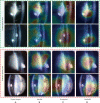Automatic classification of heterogeneous slit-illumination images using an ensemble of cost-sensitive convolutional neural networks
- PMID: 33987248
- PMCID: PMC8105862
- DOI: 10.21037/atm-20-6635
Automatic classification of heterogeneous slit-illumination images using an ensemble of cost-sensitive convolutional neural networks
Abstract
Background: Lens opacity seriously affects the visual development of infants. Slit-illumination images play an irreplaceable role in lens opacity detection; however, these images exhibited varied phenotypes with severe heterogeneity and complexity, particularly among pediatric cataracts. Therefore, it is urgently needed to explore an effective computer-aided method to automatically diagnose heterogeneous lens opacity and to provide appropriate treatment recommendations in a timely manner.
Methods: We integrated three different deep learning networks and a cost-sensitive method into an ensemble learning architecture, and then proposed an effective model called CCNN-Ensemble [ensemble of cost-sensitive convolutional neural networks (CNNs)] for automatic lens opacity detection. A total of 470 slit-illumination images of pediatric cataracts were used for training and comparison between the CCNN-Ensemble model and conventional methods. Finally, we used two external datasets (132 independent test images and 79 Internet-based images) to further evaluate the model's generalizability and effectiveness.
Results: Experimental results and comparative analyses demonstrated that the proposed method was superior to conventional approaches and provided clinically meaningful performance in terms of three grading indices of lens opacity: area (specificity and sensitivity; 92.00% and 92.31%), density (93.85% and 91.43%) and opacity location (95.25% and 89.29%). Furthermore, the comparable performance on the independent testing dataset and the internet-based images verified the effectiveness and generalizability of the model. Finally, we developed and implemented a website-based automatic diagnosis software for pediatric cataract grading diagnosis in ophthalmology clinics.
Conclusions: The CCNN-Ensemble method demonstrates higher specificity and sensitivity than conventional methods on multi-source datasets. This study provides a practical strategy for heterogeneous lens opacity diagnosis and has the potential to be applied to the analysis of other medical images.
Keywords: Cost-sensitive; deep convolutional neural networks (CNNs); ensemble learning; heterogeneous slit-illumination images; pediatric cataract.
2021 Annals of Translational Medicine. All rights reserved.
Conflict of interest statement
Conflicts of Interest: All authors have completed the ICMJE uniform disclosure form (available at http://dx.doi.org/10.21037/atm-20-6635). The authors have no conflicts of interest to declare.
Figures






References
-
- Ng EY, Acharya UR, Suri JS, et al. Image Analysis and Modeling in Ophthalmology. CRC Press, 2014.
LinkOut - more resources
Full Text Sources
Other Literature Sources
